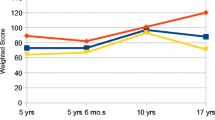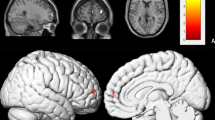Summary
Ten patients with partial callosal lesions were investigated with a broad scale neuropsychological assessment. Nine patients with a variety of lesions affecting midline structures have been operated using a direct transcallosal approach, one patient with a callosal lipoma remained unoperated. Sophisticated studies of the interhemispheric transfer of somaesthetic and perceptual motor tasks, as well as psychometric testing related to parameters of memory and attention performance were applied. The results indicate that there is no clear correlation between the site of callosal lesion and clinical symptoms. Although special disconnecting symptoms due to callosal dissection could be found, they didn't reach clinical significance. The most severe symptoms of impairment were caused by the extracallosal pathology. The results indicate that the transcallosal approach is a safe and feasible alternative in the management of pathological lesions in the midline region.
Similar content being viewed by others
References
Akelaitis, A. J., Studies on the corpus callosum. 1. Study of language functions (tactile and visual lexia and graphia) unilaterally following section of the corpus callosum. J. Neuropath. exp. Neurol.2 (1943), 226–262.
Apuzzo, M. L. J., Chikovani, O. K., Gott, P. S., Teng, E. L., Zee, C. S., Gianotta, S. L., Weiss, M. H., Transcallosal, interphonicial approaches for lesions affecting the third ventricle: Surgical considerations and consequences. Neurosurgery10 (1982), 547–554.
Bentin, S., Sahar, A., Moscovitch, M., Intermanual information transfer in patients with lesions in the trunk of the corpus callosum. Neuropsychologia22 (1984), 601–611.
Botez, M. I., Bogen, J. E., The grasp reflex of the foot and related phenomena in the absence of other reflex abnormalities following cerebral commissurotomy. Acta Neurol. Scandinav.54 (1976), 453–463.
Dandy, W. E., An operation for the removal of pincal tumours. Surg. Gynec. Obstet.33 (1921), 113–119.
Dandy, W. E., Diagnosis, localization and removal of tumors of the third ventricle. John's Hopkins Hosp. Bull.33 (1922), 188–189.
Dimond, S. J., Scammell, R. E., Brouwers, E. Y. M., Weeks, R., Functions of the centre section (trunk) of the corpus callosum in man. Brain100 (1977), 543–562.
Gazzaniga, M. S., The Bisected Brain. New York: Appleton-Century-Croft. 1970.
Geffen, G., Walsh, A., Simpson, D., Jeeves, M., Comparison of the effects of transcortical and transcallosal removal of intraventricular tumours. Brain103 (1980), 773–788.
Geschwind, N., Disconnection syndromes in animals and men. Brain88 (1965), 237–294; 585–644.
Gordon, H. W., Bogen, J. E., Sperry, R. W., Absence of deconnexion syndrome in two patients with partial sections of the neocommissures. Brain94 (1971), 327–336.
Gott, P. S., Saul, R. E., Agenesis of the corpus callosum: Limits of functional compensation. Neurology28 (1978) 1272–1279.
Hoppe, K. D., Split-brain psychoanalytic findings and hypotheses. J. Amer. Acad. Psychoanalyt.6, 2 (1978), 193–213.
Hurwitz, L. J., Evidence for restitution of function and development of new function in cases of brain bi-section. Cortex7 (1971), 403–409.
Jeeves, M. A., Simpson, D. A., Geffen, G., Functional consequences of the transcallosal removal of intraventricular tumours. J. Neurol. Neurosurg. Psychiatr.42 (1979), 134–142.
Kempe, L. G., Operative Neurosurgery, Vol. I. Berlin-Heidelberg-New York: Springer. 1968.
Kempe, L. G., Blaylock, R., Lateral-trigonal intraventricular tumours. A new operative approach. Acta Neurochir. (Wien)35 (1978), 233–242.
Ledoux, J. E., Risse, G. L., Springer, S. P., Wilson, D. H., Gazzaniga, M., Cognition and commissurotomy. Brain100 (1977), 87–104.
McKeever, W. F., Sullivan, K. F., Ferguson, S. M., Rayport, M., Typical cerebral hemisphere disconnection deficits following corpus callosum section despite sparing of the anterior comissure. Neuropsychologia19 (1981), 745–755.
McKissock, W., The surgical treatment of colloid cyst of the third ventricle. Brain74 (1951), 1–9.
McKissock, W., Colloid cysts of the third ventricle. J. Neurol. Neurosurg. Psychiatr.28 (1965), 461.
Milner, D., Neuropsychological studies of callosal agenesis. Psych. Med.13 (1983), 721–725.
Oepen, G., Schulz-Weiling, R., Zimmermann, P., Birg, W., Straesser, S., Gilsbach, J., Neuropsychological assessment of the transcallosal approach. In preparation.
Oldfield, R. C., The assessment and analysis of handedness: The Edinburgh Inventory. Neuropsychologia9 (1972), 97–113.
Olivecrona, H., Tönies, W., Surgical treatment of intracranial tumours. Handbuch der Neurochirurgie, Vol. 4, pp. 175–177. Berlin-Heidelberg-New York: Springer. 1967.
Potthoff, P. T., Umbach, W., Corpus callosum cerebri: Neue Befunde bei Balkenschäden. Dtsch. Med. Wschr.91, 2 (1966), 2220–2223.
Risse, G. L., Le Doux, J. E., Springer, S. P., Wilson, D. H., Gazzaniga, M. S., The anterior commissure in man: Functional variation in a multisensory system. Neuropsychologia16 (1978), 23–31.
Rhoton, A. L., Yamamoto, I., Peace, D. A., Microsurgery of the third ventricle: Part 2. Operative approaches. Neurosurgery8 (1981), 357–373.
Schaltenbrand, G., Über einen Fall von Persönlichkeitsspaltung infolge Balkentumor. Arch. Psychiat. Nervenkr.204 (1963), 521–530.
Schaltenbrand, G., The effects on speech and language of stereotactile stimulation in thalamus and corpus callosum. Brain and Language2 (1975), 70–77.
Seeger, W., Microsurgery of the Brain. Wien-New York: Springer. 1980.
Seeger, W., Microsurgery of the Cerebral Vessels. Wien-New York: Springer. 1984.
Shucart, W. A., Stein, B. M., Transcallosal approach to the anterior ventricular system. Neurosurgery3 (1978), 339–343.
Stein, B. M., Transcallosal approach to third ventricula tumours. In: Current techniques in operative neurosurgery (Schmiedek, H. H., Sweet, H. W., eds.), pp. 247–255. New York: Grune and Stratton. 1977.
Steingrüber, H. J., Lienert, G. A., Hand-Dominanz-Test (HDT). Göttingen: Hogrefe. 1971.
Wilson, D. H., Comment (on anterior transcallosal operation). Neurosurgery4 (1979), 393.
Winston, K. R., Cavazzuti, V., Arkins, T., Absence of neurological and behavioural abnormalities after anterior transcallosal operation for third ventricular lesions. Neurosurgery4 (1979), 386–393.
Yasargil, M. G., Jain, K. K., Antil, J., Laciga, R., Arteriovenous malformations of the splenium of the corpus callosum. Microsurgical treatment. Surg. Neurol.5 (1976), 5–14.
Zaidel, D., Sperry, R. W., Memory impairment after commissurotomy in man. Brain97 (1974), 263–272.
Zaidel, D., Sperry, R. W., Dyspraxia, Dysgraphia and Dyscopia: Long-term effects in commissurotomy patients. Caltech. Biology Annual Report (1974), 128–130.
Zaidel, D., Sperry, R. W., Some long-term motor effects of cerebral commissurotomy in man. Neuropsychologia15 (1977), 193–204.
Author information
Authors and Affiliations
Rights and permissions
About this article
Cite this article
Oepen, G., Schulz-Weiling, R., Zimmermann, P. et al. Long-term effects of partial callosal lesions. Acta neurochir 77, 22–28 (1985). https://doi.org/10.1007/BF01402301
Issue Date:
DOI: https://doi.org/10.1007/BF01402301




